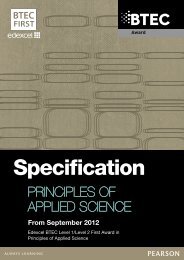BTEC First Award in Application of Science - specification - Edexcel
BTEC First Award in Application of Science - specification - Edexcel
BTEC First Award in Application of Science - specification - Edexcel
Create successful ePaper yourself
Turn your PDF publications into a flip-book with our unique Google optimized e-Paper software.
UNIT 5: APPLICATIONS OF CHEMICAL SUBSTANCES<br />
Assessment criteria<br />
Level 1 Level 2 Pass Level 2 Merit Level 2 Dist<strong>in</strong>ction<br />
Learn<strong>in</strong>g aim A: Investigate and understand enthalpy changes associated with chemical reactions<br />
1A.1 Measure the temperature<br />
changes associated with<br />
chemical reactions.*<br />
2A.P1 Investigate temperature<br />
changes associated with<br />
exothermic and<br />
endothermic reactions<br />
us<strong>in</strong>g primary data.*<br />
2A.M1 Expla<strong>in</strong> why an overall<br />
reaction is exothermic or<br />
endothermic.*<br />
2A.D1 Calculate the energy<br />
changes that take place<br />
dur<strong>in</strong>g exothermic and<br />
endothermic reactions.*<br />
Learn<strong>in</strong>g aim B: Investigate organic compounds used <strong>in</strong> society<br />
1B.2 Identify the uses <strong>of</strong> the<br />
ma<strong>in</strong> fractions from the<br />
distillation <strong>of</strong> crude oil.<br />
2B.P2 Describe the fractional<br />
distillation <strong>of</strong> crude oil to<br />
produce a range <strong>of</strong><br />
useful products.<br />
2B.M2 Expla<strong>in</strong> how fractional<br />
distillation separates<br />
compounds due to<br />
different boil<strong>in</strong>g ranges.<br />
2B.D2 Analyse the relationship<br />
between the boil<strong>in</strong>g<br />
range and the length<br />
<strong>of</strong> carbon cha<strong>in</strong> <strong>of</strong><br />
fractions.*<br />
1B.3 Name alkanes and<br />
alkenes from structural<br />
and displayed formulae.<br />
1B.4 Identify an alkene and<br />
an alkane us<strong>in</strong>g primary<br />
observations.<br />
2B.P3 Draw accurately the<br />
structural and displayed<br />
formulae <strong>of</strong> organic<br />
molecules.<br />
2B.P4 Identify an alkene and a<br />
carboxylic acid us<strong>in</strong>g<br />
primary observations.<br />
2B.M3 Describe the bond<strong>in</strong>g<br />
and structure <strong>of</strong> organic<br />
molecules.<br />
2B.M4 Expla<strong>in</strong> how a series <strong>of</strong><br />
experiments can be used<br />
to identify organic<br />
compounds based on<br />
their solubility and<br />
reactions.<br />
2B.D3 Expla<strong>in</strong> the results <strong>of</strong><br />
experiments to identify<br />
organic compounds <strong>in</strong><br />
terms <strong>of</strong> their reaction<br />
type, structural and<br />
displayed formulae, and<br />
bond<strong>in</strong>g.<br />
1B.5 Identify uses <strong>of</strong> ethene,<br />
ethanol and ethanoic<br />
acid.<br />
2B.P5 Describe the uses <strong>of</strong><br />
organic compounds <strong>in</strong><br />
our society.<br />
2B.M5 Expla<strong>in</strong> the problems<br />
associated with the use<br />
<strong>of</strong> organic molecules.<br />
2B.D4 Evaluate the benefits<br />
and drawbacks <strong>of</strong> us<strong>in</strong>g<br />
organic materials.<br />
BF029957 – Specification – <strong>Edexcel</strong> <strong>BTEC</strong> Level 1/Level 2 <strong>First</strong> <strong>Award</strong> <strong>in</strong> <strong>Application</strong> <strong>of</strong> <strong>Science</strong> –<br />
Issue 1 – March 2012 © Pearson Education Limited 2012<br />
43








